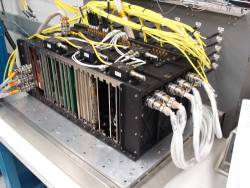 The advanced MDU on navigation payloads being delivered for GPS III Space Vehicles 1-10. Photo courtesy of Harris Corp.
The advanced MDU on navigation payloads being delivered for GPS III Space Vehicles 1-10. Photo courtesy of Harris Corp.Harris Corporation has completed development of the company’s fully digital Mission Data Unit (MDU), which is at the heart of its navigation payload for Lockheed Martin’s GPS III satellites 11 and beyond.
Harris Corporation has completed development of the company’s fully digital Mission Data Unit (MDU), which is at the heart of its navigation payload for Lockheed Martin’s GPS III satellites 11 and beyond.
The current Harris payload for GPS III space vehicles (SVs) 1-10 includes a greater than three times reduction in range error, up to eight times increase in anti-jamming power, added signals – including one compatible with other GNSSs – and greater signal integrity. Harris’ GPS III SV11+ fully digital navigation payload will further improve on performance for the U.S. Air Force by providing more powerful signals, plus built-in flexibility to adapt to advances in GPS technology, as well as future changes in mission needs, according to the company.
“This design is fully mature – an Engineering Development Model, not a prototype – and is ready to be inserted into GPS III SV11+,” said Bill Gattle, president, Harris Space and Intelligence Systems. “The payload has the flexibility to serve the warfighter over the entire mission life and can be upgraded incrementally over its mission life due to built-in adaptability.”
The payload design also ensures flawless atomic clock operations, providing the reliable GPS signal that millions of people – including U.S. soldiers – and billions of dollars in commerce depend on every day. It also will provide the clock signal for a new GPS III Search and Rescue (SAR) payload.
Beyond flexibility and reliability, the new Harris SV11+ navigation payload offers a smooth transition to the Air Force’s GPS Next Generation Operational Control System (OCX) ground control segment. The Harris payload for the first 10 GPS III satellites already has been verified for OCX compatibility, and this will allow Harris to seamlessly port the Harris SV11+ design, minimizing integration risks and associated costs.
According to Harris, the development’s highlights include:
• Results in the most reliable, versatile GPS navigation payload yet
• Further improves on capabilities of 70-percent-digital payload for GPS III SV01-10
• Extends 40-plus-year legacy of GPS payload technology leadership
In related news, the Space and Missile Systems Center (AFSPC) announced last week that the United States Air Force had accepted delivery of the Global Positioning System Next Generation Operational Control System (GPS OCX) Launch and Checkout System (LCS) baseline from Raytheon Intelligence and Information Systems.




